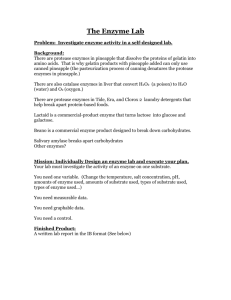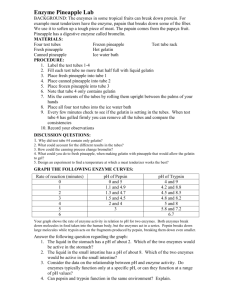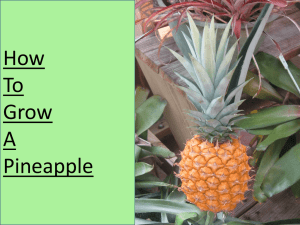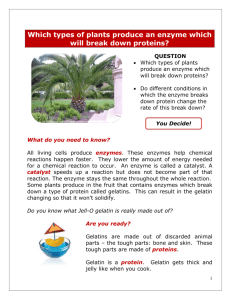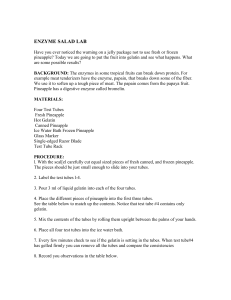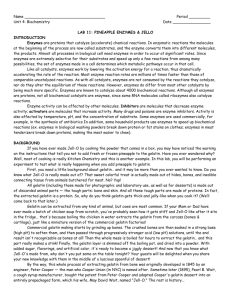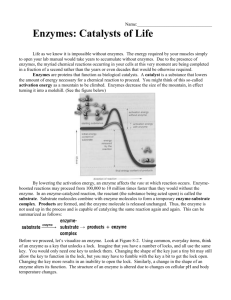Pineapple Enzyme Lab: Bromelain & Gelatin Experiment
advertisement
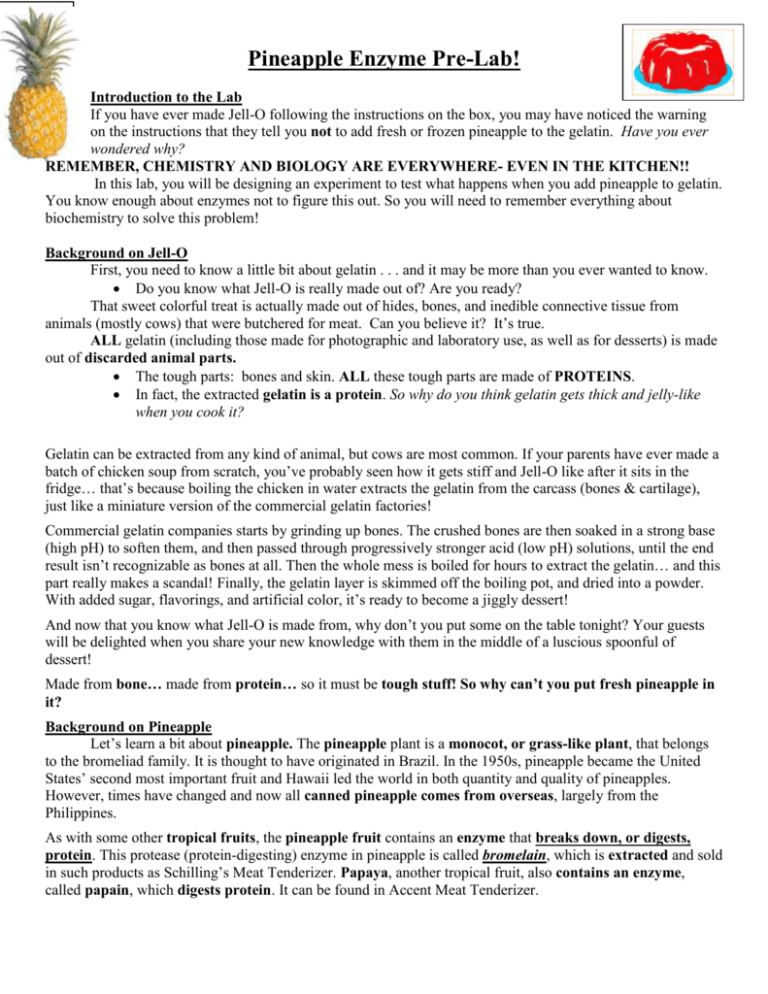
Pineapple Enzyme Pre-Lab! Introduction to the Lab If you have ever made Jell-O following the instructions on the box, you may have noticed the warning on the instructions that they tell you not to add fresh or frozen pineapple to the gelatin. Have you ever wondered why? REMEMBER, CHEMISTRY AND BIOLOGY ARE EVERYWHERE- EVEN IN THE KITCHEN!! In this lab, you will be designing an experiment to test what happens when you add pineapple to gelatin. You know enough about enzymes not to figure this out. So you will need to remember everything about biochemistry to solve this problem! Background on Jell-O First, you need to know a little bit about gelatin . . . and it may be more than you ever wanted to know. Do you know what Jell-O is really made out of? Are you ready? That sweet colorful treat is actually made out of hides, bones, and inedible connective tissue from animals (mostly cows) that were butchered for meat. Can you believe it? It’s true. ALL gelatin (including those made for photographic and laboratory use, as well as for desserts) is made out of discarded animal parts. The tough parts: bones and skin. ALL these tough parts are made of PROTEINS. In fact, the extracted gelatin is a protein. So why do you think gelatin gets thick and jelly-like when you cook it? Gelatin can be extracted from any kind of animal, but cows are most common. If your parents have ever made a batch of chicken soup from scratch, you’ve probably seen how it gets stiff and Jell-O like after it sits in the fridge… that’s because boiling the chicken in water extracts the gelatin from the carcass (bones & cartilage), just like a miniature version of the commercial gelatin factories! Commercial gelatin companies starts by grinding up bones. The crushed bones are then soaked in a strong base (high pH) to soften them, and then passed through progressively stronger acid (low pH) solutions, until the end result isn’t recognizable as bones at all. Then the whole mess is boiled for hours to extract the gelatin… and this part really makes a scandal! Finally, the gelatin layer is skimmed off the boiling pot, and dried into a powder. With added sugar, flavorings, and artificial color, it’s ready to become a jiggly dessert! And now that you know what Jell-O is made from, why don’t you put some on the table tonight? Your guests will be delighted when you share your new knowledge with them in the middle of a luscious spoonful of dessert! Made from bone… made from protein… so it must be tough stuff! So why can’t you put fresh pineapple in it? Background on Pineapple Let’s learn a bit about pineapple. The pineapple plant is a monocot, or grass-like plant, that belongs to the bromeliad family. It is thought to have originated in Brazil. In the 1950s, pineapple became the United States’ second most important fruit and Hawaii led the world in both quantity and quality of pineapples. However, times have changed and now all canned pineapple comes from overseas, largely from the Philippines. As with some other tropical fruits, the pineapple fruit contains an enzyme that breaks down, or digests, protein. This protease (protein-digesting) enzyme in pineapple is called bromelain, which is extracted and sold in such products as Schilling’s Meat Tenderizer. Papaya, another tropical fruit, also contains an enzyme, called papain, which digests protein. It can be found in Accent Meat Tenderizer. Enzymes Proteins have many, many jobs. Some proteins are called ENZYMES (or CATALYSTS), and they have very special jobs. Here is the definition of enzymes: “proteins that regulate or speed up chemical reactions in living organisms.” We have enzymes all over in our body. Without them, our bodies couldn’t perform any of the thousands of chemical reactions we need to do every day, just to stay alive. We wouldn’t even be able to digest (break down) the food we eat! What does Pineapple Taste Like? ***REMEMBER: IT IS NOT SAFE TO EAT WHILE DOING A LAB. DO NOT EAT ANY PINEAPPLE THAT IS IN THE LAB.*** Think back to when you have eaten fresh and canned pineapple. There you have it. Jell-O. Made from bone…made from protein…so it must be tough stuff, right? So why can’t you put fresh pineapple in it? So let’s investigate!! PRE-LAB QUESTIONS: (You may need to refer to your class notes to answer these questions) 1. Chemically speaking, what is gelatin made of (is it a carbohydrate, a protein, or a lipid)? 2. How is gelatin produced? Explain how it is extracted to the finished product. 3. What are enzymes and what do they do? 4. What enzyme is found in pineapple? 5. How do meat tenderizers work? 6. What does it mean for a protein to be denatured and how can they become denatured? 7. What might happen to proteins after you heat them up? 8. In words that a third grader could understand, state what an enzyme is. 9. What is a protein? Pineapple Enzyme Lab Objective: SWBAT: Test for the presence of enzymes in fruit, their specificity and how environmental factors such as temperature and pH alter the structure and function of enzyme activity. In this enzyme lab, you will use pineapple as an enzyme and Jell-O as a substrate to illustrate an enzyme/substrate complex. The guided procedure will allow you to discover that the processing of food, specifically canned pineapple, will denature the enzymes and render them useless. You will focus on the behavior, function and the effect that environmental factors have on enzyme activity. The environmental factors that you are going to explore include: temperature and pH. Materials: -Petri dish w/ pre-made strawberry jell-o (3) -Fresh pineapple -Canned pineapple -Spoon Procedure: In this lab, you will test the effect of pineapple (both fresh and canned) on gelatin. The goal is to get a general understanding of the characteristics of enzymes, their function and vulnerability to denaturing when exposed to a variety of environmental factors (temperature, pH, concentration), 1. You will be given 3 petri dish of pre-made jell-o. 2. Label the 3 petri-dish as follows: control, fresh, and canned. 3. Place a small piece of the appropriate fruit in all petri-dish except the one you labeled the control. 4. Observe the experimental set-up for 40 minutes. 5. Record observations at every 5-minute intervals in a data table. 6. Write your predictions in the table below. CLEAN-UP 1. Filter all petri-dish in the container in front of the room labeled “Jell-O Mix” 2. Do NOT pour them down the drain! 3. Rinse the petri dish and put it upside down on the tray to dry on the left side of the room. 4. Put the spoon back in the cup in the front of the room. 5. Clean up your area! Make sure the lab area is not left sticky!! Jell-O Enzyme Lab I. Problem a. What will happen when fresh pineapple is placed in jell-o? b. What will happen when canned pineapple is placed jell-o? II. Hypothesis a. If we put the fresh pineapple in the jell-o then……. Because…….. b. If we put the canned pineapple in the jell-o then….. Because…….. III. Procedure a. Identify i. Controlii. Independent Variableiii. Dependent Variableb. Steps for the Experiment 1. 2. 3. 3. 5. 6. IV. Results Activity: Fruit Added to Jell-O Observed Effect on Gelatin (Jell-O) **Record Every 5 minute intervals** Control (no added fruit) Fresh Pineapple Canned Pineapple V. 1. 2. 3. 4. Conclusion Explain the results of your experiment. What explained for the differences between the petri-dishes? Which type of pineapple in your experiment has active enzymes? How do you know? A substrate is the chemical that enzymes act on. What is the substrate in your experiment? The enzyme in pineapple that dissolves protein is called bromelain. Write a word “equation” to explain the chemical reaction that took place in one of your petri-dish. Hint: Reactants Product 5. Is this chemical reaction an example of SYNTHESIS (building) or HYDROLYSIS (breaking down)? 6. What interprets for the difference between fresh and canned pineapple? (HINT- what happens to the enzyme bromelain when pineapple is canned?) 7. Knowing the results of your experiment, why does your tongue get sore when you eat too much raw pineapple? (HINT- what is your tongue made of?) KEY KEY KEY KEY KEY KEY KEY KEY KEY KEY KEY KEY A protein is: a complex molecule made from a chain of amino acids. It is folded into a specific shape in order to perform a specific job. What might happen to proteins after you heat them up? They will denature. In words that a third grader could understand, state what an enzyme is.Answers will vary. What might account for the difference in canned and fresh? The enzymes in the canned pineapple have been denatured and no longer work in the canned pineapple. Which type of pineapple in your experiment has active enzymes? How do you know? the fresh pineapple because it dissolved the jello. A substrate is the chemical that enzymes act on. What is the substrate in your experiment? The jello. The enzyme in pineapple that dissolves protein is called bromelain. Write a word equation to explain the chemical reaction that took place in one of your test tubes. bromelain Protein in jello amino acids IS THIS CHEMICAL REACTION AN EXAMPLE OF DEHYDRATION SYNTHESIS OR HYDROLYSIS? Hydrolysis What accounts for the difference between raw and fresh pineapple? (HINT- what happens to the enzyme bromelain when pineapple is canned?) the enzyme is denatured during the canning process Knowing the results of your experiment, why does your tongue get sore when you eat too much raw pineapple? (HINT- what is your tongue made of?) the bromelain is dissolving the protein that makes up your tongue. Notes: 1. Petri dishes work really well for jello containers if you are having students work with it themselves. They also stack very nicely in a refrigerator. For the demo version, it is much easier to just pick up a six pack of pre-made jello. 2. If you get in a pinch, jello also liquefies if you put it in the microwave for five seconds! 3. This may be obvious, but remember to cut up the fresh pineapple at home. One year, I picked up my fresh pineapple while on my lunch break and only then realized that I obviously had no knife or cutting board at school. Then I had to scramble for that day’s lesson and travel both home and back to work again with a pineapple . . . not fun!

